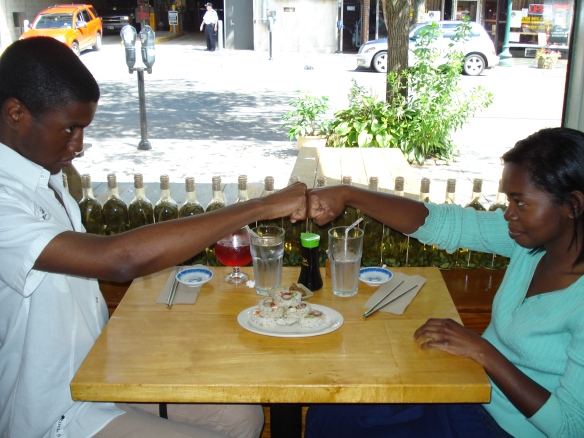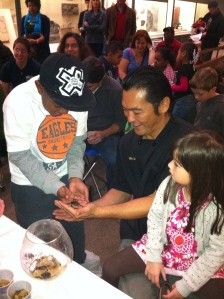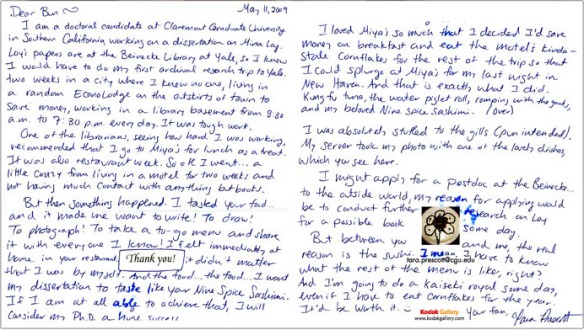Men and Women make different kinds of chefs
Bun,
I wanted to take a moment to send you a message about our experience at your lovely restaurant. My mother, her boyfriend, and I came in for dinner late on Saturday night after they picked me up from a dreadfully late flight from Chicago. I lived in New Haven from 2000-2005 and my mother now lives there (in Wooster Square). I had only been to Miya’s once during my time in New Haven (can’t recall why that is) but insisted that we go during my latest visit home upon recommendation from a local friend.
Well, despite the late hour (and my overly hungry stomach), it was a lovely and memorable experience – perhaps even one of the highlights of my last trip to the Elm City. Yes, the food was very tasty and thoughtfully prepared but the pleasant experience was more holistic. Your menu items were unusual, creative, and above all fresh. In addition, the service was heartfelt. We left feeling like our spirits had been cared for and our bellies loved. We especially enjoyed talking to you and getting your personal recommendations.
After you left, your mother, Yoshiko, came over to the table and talked with us about the restaurant, her family, and her love for her family. She also shared some wonderful green tea with us, which she served from her special china. I found something she said especially profound and have been thinking about it ever since Saturday evening. She said that women and men make different kinds of chefs because of the way that they are socialized. Women are taught to cook on a budget, the stretch a given sum of money as far as it can go to feed many mouths. Whereas, men create from pure extravagance and desire. One sex is not necessarily better in the kitchen – just different. Naturally, I am paraphrasing her beautiful words, but it went something like this.
Given my exhaustion and hunger, I didn’t pay much attention to the part of the menu apart from what I could devour. But mom picked up one of your menus to bring home and she read it cover to cover. For my first 24 hrs at home, she raved about your musings and said it was more of a life and passion philosophy than a menu. On Monday night, her boyfriend, Robert, who is a CIA-trained chef fixed the two of us an amazing dinner. And during dessert, mom pulled out your menu and recited excerpts as if she was reciting Yeats or Emerson. What lovely thoughts! And we all agreed that reading these enhanced our reminiscing of the evening at Miya’s.
We are all very picky eaters and have been to multiple wonderful restaurants around the world – Jean George, Morimoto, Chez Panisse- but Miya’s will certainly stick out as one of our most enjoyable and memorable spots. And how lucky that it is right in our backyard!
Jennifer Jordan,
Author, “Harnessing Power To Capture Leadership.”
Kellogg School of Management – Ford Center for Global Citizenship
Reclaiming the Kwanzaa Bonanza
Dear Miya’s Sushi,
My dear friend Bernice and I had lunch yesterday in your establishment. It was Bernice’s first Miya’s experience. When she ordered the Kwanzaa Bonanza roll–which I had been telling her about ever since I first ate at Miya’s back in 2008–our server, a lovely young woman named Anna, told us that she had recently waited on a couple who, upon tasting the Kwanzaa Bonanza roll for the first time, high-fived each other. Bernice and I were pleased by this couple’s story and excited about the thought of Bernice’s having a similar experience…that is until Anna, upon further questioning, revealed that the couple from the story was white.
Shocked, appalled, and not to be outdone, Bernice and I were determined to reclaim the
Kwanzaa Bonanza roll in the name of the black people for whom it was so generously and
thoughtfully created. Therefore, it is with great pleasure that we send to you the attached
photograph, taken by our delightful and obliging waitress Anna, in which Bernice and I celebrate not only the exquisiteness that is Kwanzaa Bonanza, but also all that we love about our blackness.

Reclaiming the Kwanzaa Bonanza
More Food For Thought…
Bun,
Great being with you last night, permitted to put the pedal to the floor. Of course there’s much more.
I urge you to think more about that first act of Biblical eating. The fruit (not an apple) is described in Genesis Chapter 3 as “good for eating, a delight to the eyes, …a desirable source of wisdom.” The snake said to the woman, “You are not going to die but God knows that as soon as you eat of it your eyes will be opened, you will be like God, knowers of good and bad.”
That food is eaten by the eyes, that the eyes make initial contact with the morsel, this of course you know better than I. But that in eating we seek wisdom and discrimination even as we fear or face dying, this is perhaps less familiar a way to think about ingesting. In eating we seek to become like God. Through eating we discover our naked humanity and simultaneously our link to deity.
This last observation is captured I think in the Hebrew blessing mandated by the Talmud to be recited AFTER eating virtually anything, beginning with a glass of water or any juice, save grape juice or wine. “You are the Source of Blessing, Creator of myriad souls and of their neediness that weighs upon all that You created in order to revive through them the soul of each life.” A little ponderous but thus it is, more or less. Eating allows an experience of resurrection, of near-death and re-birth. Naked we are born and naked we die. Or as Job put it, “Naked came I out of my mother’s womb and naked shall I return there.”
In eating we meet God and lose God, eat God, as it were, become God (as in “You are what you eat.”) and lose God (as in “You can’t eat your cake and have it too.”) In eating we become naked babes, nursling, sucking at the breast of life. Babes are innocent but in adult eating there is always a dimension of the forbidden, a guilt that we must destroy, kill, mash, sunder, mutilate in order to survive. The guilt over eating precedes the guilt over sex, but it is the same guilt. It is the belief that we are not lovers but rather greedy, hungry murderers. The blessing cited above tries, I think, to remove the toxin of guilt from the experience of appetite and satisfaction, to remove the shame that enters Eve’s and Adam’s mind after eating that fruit.
The Talmud, by the way, reckons that different foods require different blessings. Both before and after eating. This category of law may be worth pursuing further. Thus before a glass of water one says, “You are the Source of blessing through whose word everything comes to be.” Eating then is like speaking. One thinks of the magnificent opening to the Gospel of John: “In the beginning was the word, and the word was with God, and the word was God. He was in the beginning, with God. Everything came about through him, and without him not one thing came about. What came about in him was life, and the life was the light of mankind; and the light shines in the darkness, and the darkness did not understand it.”
The miracle of mouth, organ of ingestion, kissing, biting, eating and speaking. We speak light and we eat light.
Before bread, You are the Source of Blessing who makes bread come forth from the earth.
Before wine and grape juice, You are the Source of Blessing, creator of the fruit of the vine.
After bread a massive blessing that has grown over the centuries. The notion of blessing after you eat is already in the Bible, in Deuteronomy 8: 7 – 10, the fifth of the five books, say a 7th century BC work, which, referencing the seven species, says, “For the Lord your God is bringing you into a good land, a land with streams and springs and fountains issuing from plain and hill; a land of wheat and barley, of vines, figs and pomegranates, a land of olive trees and honey; a land where you may eat food without stint, where you will lack nothing; a land whose rocks are iron and from whose hills you can mine copper. You shall eat and be satisfied and then bless the Lord your God for the good land he has given you.”
The notion of satisfaction as the precondition for making a blessing is Biblical. In the Bible one becomes capable of offering blessing on the full stomach, for blessing emerges from the experience of abundance. The Talmud tries to inculcate the notion of being satisfied with a little and thus teaches the obligation to bless even if you have only consumed “an olive’s worth” of food. It also introduces the obligation to bless prior to eating, suggesting that one who eats without first blessing is a thief. The world is the Lord’s and the fullness thereof. The blessing turns booty into gift, forbidden into permitted, consumption into offering. The role of word in the context of eating. The role of eating in the context of word. Animal sacrifice in the Temple was also an attempt to propitiate blood guilt.
The Rolling Stones taught the troubling truth that “I can’t get no satisfaction.” Satisfaction is indeed the great gift. But so too is hunger, desire, yearning. Compare “Blessed are you who hunger now, because your hunger shall be satisfied.” from Luke. In The Hebrew Bible you can be “satisfied of days” like Abraham, Isaac and Job. Achieving satisfaction, the experience of enough, sufficiency, adequacy is spiritually important. To go beyond neediness, like Siddharta as rendered by Hesse who says, “I can wait, I can meditate and I can fast.”
Which leads us to fasting, binging, purging. And all the curiosities of kashrut. But that perhaps for another time.
Wonderful thinking this stuff through with you. Food for thought.
Rabbi James E. Ponet
Howard M. Holtzmann Jewish Chaplain
Joseph Slifka Center for Jewish life at Yale

An Easter gift from Dawn
Dear Bun,
I would like to thank you for the magical evening. We have had so many together, but paradoxically, each seems to be unique and special. Upon reflection, this is the magic of a night at Miya’s with Bun presiding as sorcerer.
Goethe once wrote that “ one ought, every day at least, to hear a little song, read a good poem, see a fine picture, and if it were possible to speak a few reasonable words.” Though I feel some trepidation in amending such fine words from such a supremely perceptive man, I dare say that “Goethe, if he ever dined at Miya’s, would have included “to eat a lovely meal, and pass time with a beautiful soul,” to his requisites for a good day.
Not many bring such goodness into the world for others to experience and take into their lives. It is the combination of a rare gift and creative energy. You should know this.
Yancy Orr
Anthropology, University of Arizona
Supernatural Bull$#!* Powers
Bun,
Hey–you run an amazing place! You know I’m a 100% straight shooter, so you can count on it when I tell you that the VERY worst thing I can say about tonight is that I wouldn’t have served the catfish last–and I had to beat my brains to come up with even that. Every single dish was fantastic. I’d be at a loss to tell anyone what to order. My advice to friends (and I will direct as many of them as I can your way) will simply be to put themselves in the hands of the great chef. It was wonderful to see you in person, and even better to see you working in a business where you can put your supernatural bullshitting powers to work for you. When I get back to LA, I’ll break out the pencil and paper and make you something suitable for framing.
Jay Lender
Writer/Director, Sponge Bob Square Pants
Hello Miya’s Staff and Owner,
You may remember me: I provided you with a new quote last night: ”The food is so good our tongues are speechless.” I was there with two new friends from New Haven.
The tasting menu was unbelievable!
I am 61 years old, a musician, and I have had great meals all over the world, in Tokyo, Buenos Aires, Paris, Rome, Florence, Milan, Los Angeles, Santa Fe, San Francisco, New Orleans, and New York–where I live–and I have to say this meal was one of the 5 or so great dining experiences of my life. Each course was so amazing and original and creative that we were convinced that the next one could not possibly be as good, but it was even better–FOR ALL 10 COURSES! It was impossible to pick a favorite, although for sheer outrageousness inventiveness, the catfish and cheese wrapped in grits (am I remembering correctly?) has to be right up there. And to top accompany it, the Firecracker Saki. OMYGODAREYOUKIDDINGME?!!!!!!! Outrageously great!!!!!!!
I am still in a true state of shock and awe at the food and the entire dining experience. Our waitress was also a complete and total genius at delivering the descriptions and hilarious titles of the dishes in a completely deadpan manner that left us in stitches. Sign her to a lifetime contract!
Thank you from the bottom of my heart and palette for an extraordinary dining experience. I hope to return very, very, very soon, with more friends in tow. Until then, wishing you continued success and exploration,
Guy







